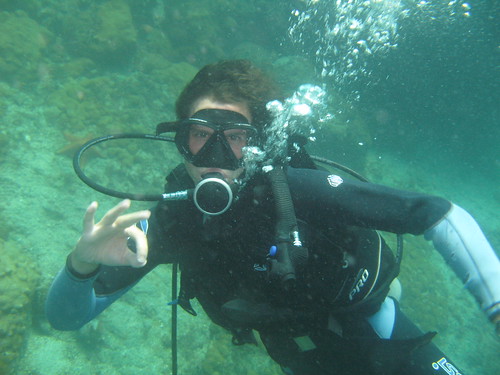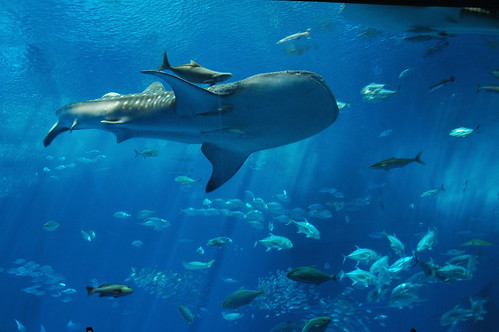Diving Suit or Wetsuit is an important in scuba diving as an air tank. There is a thin layer of water that is allowed to get between the suit and the skin of the diver. The skin of the diver will warm the water. It is an essential piece of scuba gear. Choosing the appropriate wetsuit, however, depends upon many factors and preferences. When immersed in a body of water, the human body loses stored heat 20 times faster compared to the standard conductivity rates on land. In this regard, the wetsuit has been designed to minimize the loss of body heat by trapping energy between the scuba gear's material and the pores of your skin during the dive in Underwater.
Photo: wwarby
Water conducts heat away from the body approximately 25 times more efficiently than air, so an unprotected individual can succumb to hypothermia even in warm water on a warm day. Wetsuits are made out of closed cell, foam neoprene, a synthetic rubber that contains small bubbles of nitrogen gas when made for use as wetsuit material. Nitrogen gas has very low thermal conductivity, so it reduces heat from the body from being lost to the water outside of the wetsuit.
The wetsuit benefits are not without controversy though, as those who utilize a suit in open water swimming events and triathlons believe that they enjoy a competitive advantage over those not wearing a suit. It is believed that a wetsuit benefits the wearer in terms of buoyancy and hydrodynamic curve, the later term basically meaning that the individual gets a distinct advantage from the more streamlined effect, as well as additional water forces aiding the wearer. In some triathlons the competitors are not allowed to wear a wetsuit and one should inquire as to whether this is allowed or not prior to entry in such a triathlon, as this may result in disqualification from winning any prizes in the competition.
Wetsuits come in different thicknesses depending on the conditions for which it is intended. The thicker the suit, the warmer it will keep the wearer. Because wetsuits offer significant protection from jellyfish, coral and other hazards, many divers opt to wear a thin suit which provides minimal insulation (often called a "bodysuit") even when the water is warm enough to comfortably forego insulating garments. A thick suit is stiff, so mobility is restricted; at a certain thickness the suit would become impractical, which is why drysuits must be worn in particularly cold environments. A wetsuit is normally described in terms of its thickness. For instance, a wetsuit with a torso thickness of 5 mm and a limb thickness of 3 mm will be described as a "5/3". With new technologies the neoprene is getting more flexible. Modern 4/3 wetsuits, for instance, may feel as flexible as a 3/2 of only a few years ago. Some suits have extra layers added for key areas such as the lower back.
Photo: vikingdiveroh
Different shapes of wetsuit are available, in order of coverage:
- A sleeveless vest, covering only the torso, provides minimal coverage. Some include an attached hood. These are not intended to be worn alone, but rather as an extra layer over or under a longer wetsuit.
- A jacket covers the torso and arms, with little to no coverage for the legs. Some jackets have short leg sleeves like a shorty, others feature leg holes similar to a women's swimsuit. A third style, the beavertail, which was quite popular until the 1980s, had a flap which closed over the crotch and attached at the front with a fastener.
- A shorty or spring suit covers the torso and has short sleeves for the arms and legs. There are also forms of spring suits with long arms and short legs.
- A long john or farmer john/jane (depending on the gender the suit is designed for) covers the torso and legs only; it resembles a bib-and-brace overall, hence the nickname.
- A full suit or steamer covers the torso and the full length of the arms and legs.
- A legless wetsuit is available, although rare. They consist of long sleeves or none at all and no legs so the suit covers the crotch and most of the buttocks.
Usually they have no feet or hood, and the diver must wear separate booties and hood made from wetsuit material. Using hoods: in the thermal balance of the human body, the heat loss over the head is at least 20% of the whole balance. Thus, for the sake of thermal protection of the diver, wearing a well-fitting hood is good practice, even at fairly moderate water temperatures.
A specialized kind of wetsuit, with a very smooth and somewhat delicate outer surface is used for long distance swimming and triathlon. These are designed to maximize the mobility of the limbs while providing both warmth and buoyancy.
Heated wetsuits also being tested and will soon be available on the market. These suits have special heating panels integrated in the back of the wetsuit. The power for heating comes from batteries also integrated into the wetsuit. Smaller Wetsuits are even made for children in many sizes, types, and thicknesses.

U.S. Divers Mercury Full Adult Wetsuit
Find a fine wetsuit by comparison, The Mercury is just as good as any of other brands. This U.S. Divers' Mercury wetsuit made of the highest quality materials available offers a superior combination of fit, performance and style. The full size suit is distinguished by its titanium blend 3 mm chest panels, which reflect heat back to the body to keep divers and surfers warm in frigid conditions and the 2 mm side panels, which are pliable enough for upper body twists.
The suit also features a super-stretch panel under each arm for added flexibility. And thanks to the neoskin seals on the neck, legs, and wrists, the suit seals out water with aplomb. Other details include flat-lock stitching for extra comfort, a pull chord with a double tap hook and loop tie down to keep the suit fully sealed, and anti abrasion knee pads to minimize rubbing and scraping. Available in a variety of sizes, the Mercury suit is backed by a two year limited warranty.
Source: wikipedia.org, babywetsuits.com



